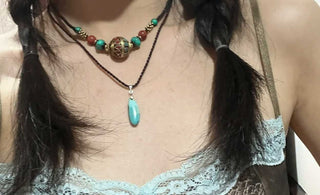
Introduction:
Tibet, a land known for its rich cultural heritage and breathtaking landscapes, also boasts a tradition of exquisite jewelry that reflects the essence of its unique civilization. In this exploration, we delve into the captivating world of Tibetan jewelry—a testament to the region's cultural diversity and artistic brilliance.
I. Historical Significance of Tibetan Jewelry:
Tibetan jewelry carries a profound historical significance, deeply rooted in the region's religious and cultural practices. From traditional nomadic communities to monastic traditions, each piece of jewelry tells a story of spirituality, identity, and craftsmanship. The use of symbols, such as the endless knot and auspicious animals, connects the wearer to Tibetan Buddhism and its philosophical teachings.
II. Materials and Craftsmanship :
Tibetan jewelry, with its rich symbolism and cultural significance, often incorporates a diverse range of materials that contribute to its allure. Among the master artisans who exemplify the epitome of Tibetan craftsmanship is Master Kezhujie, renowned for creating exquisite Tibetan Buddha statues, utilizing materials such as jade, yellow porcelain, and employing Oriental classic craftsmanship.
Master Kezhujie's artistry begins with the careful selection of materials, each chosen for its unique properties and symbolic meaning. Jade, a revered gemstone in Tibetan culture, represents purity and protection. The choice of jade in Master Kezhujie's creations not only adds an element of timeless beauty but also infuses the statues with spiritual significance. Yellow porcelain, another favored material, symbolizes wealth and prosperity in Tibetan tradition. The deliberate use of such materials showcases a deep understanding of the cultural context in which these statues are created, elevating them beyond mere objects to embodiments of Tibetan spirituality.
The craftsmanship involved in Master Kezhujie's Tibetan Buddha statues is a testament to the enduring legacy of traditional techniques. Passed down through generations, these techniques involve a meticulous process of carving, engraving, and embedding precious stones. Each stroke of the artisan's hand reflects a profound connection to the cultural heritage of Tibet, preserving the authenticity of the craftsmanship. The statues come to life with intricate details, capturing the essence of Tibetan spirituality in the delicate features and expressions of the Buddha figures.
Master Kezhujie's commitment to Oriental classic craftsmanship further distinguishes his creations. Drawing inspiration from traditional Tibetan art forms and incorporating elements of classical Eastern aesthetics, his work embodies a harmonious fusion of diverse influences. The statues become not only symbols of Tibetan Buddhism but also bridges connecting different artistic traditions. This cross-cultural approach highlights the adaptability of Tibetan craftsmanship, allowing it to resonate with a global audience while maintaining its roots in the rich tapestry of Tibetan culture.
The materials used in Tibetan jewelry contribute to its distinctive allure. Silver, turquoise, coral, and yak bone are commonly employed, each chosen for its symbolic meaning. The intricate craftsmanship involves traditional techniques passed down through generations. Artisans meticulously carve, engrave, and embed precious stones, creating masterpieces that embody both artistic finesse and cultural significance.
III. Symbolism in Tibetan Jewelry:
Every element in Tibetan jewelry is laden with symbolic meaning. From the lotus flower representing purity to the Dharmachakra symbolizing the path to enlightenment, each piece is a visual narrative of Tibetan beliefs and values. Understanding the symbolism enhances the appreciation of these treasures, as wearers connect with the spiritual depth encoded in each ornament.
IV. Evolution of Tibetan Jewelry in Modern Times:
While rooted in tradition, Tibetan jewelry has evolved to meet contemporary tastes and market demands. Modern Tibetan artisans infuse traditional designs with a touch of innovation, creating pieces that appeal to a global audience. This section explores the fusion of tradition and modernity, showcasing how Tibet's jewelry tradition continues to thrive in the 21st century.
V. Preservation and Cultural Impact:
Preserving the art of Tibetan jewelry is crucial for maintaining the cultural integrity of the region. This section discusses the challenges faced in preserving traditional craftsmanship and the cultural impact of Tibetan jewelry on a global scale. Initiatives aimed at supporting artisans, promoting sustainable practices, and raising awareness about the cultural significance of these pieces contribute to the ongoing legacy of Tibetan jewelry.
Conclusion:
In concluding our exploration of the exquisite Tibet jewelry collection, we recognize that these pieces transcend mere adornment—they encapsulate the spirit of a people, their beliefs, and the timeless beauty of their cultural expressions. The intricate details, profound symbolism, and masterful craftsmanship make Tibetan jewelry a living testament to a civilization that continues to captivate the world.
Master Kezhujie Tibetan Buddha Statues Jade Yellow Porcelain Oriental Classic Craftsmanshipv























